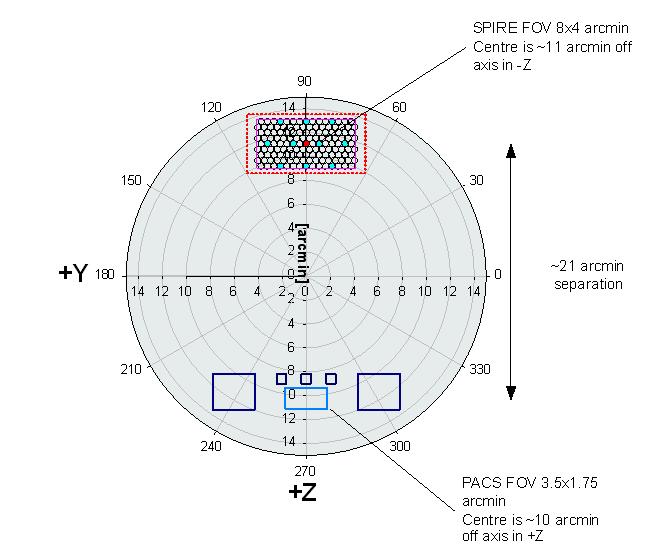The Parallel Mode AOT is offered with only one observing mode: scanning. It is the only compatible mode for operating SPIRE and PACS simultaneously: in fact, scan mode is the only option for both SPIRE and PACS to map large areas of the sky, even when they are operated alone.
The scanning strategy has been optimized for both instruments. Scan maps are performed by slewing the spacecraft at a constant speed along parallel lines to cover a large area. The lines follow great circles on the sphere which approximates parallel lines over short distances. When finishing a scan leg, the spacecraft has to perform a turn maneuver and continue observing along the next scan leg in the opposite direction: the time required for this turn is about half a minute. Note that scan mapping does not make use of chopping, being the signal modulation provided by the spacecraft motion.
Two scan speeds are offered: the fast mode applies 60 arcseconds per second, the slow mode is performed at 20 arcseconds per second. Applying the fast mode (default value), PACS PSF is degraded due to on-board data averaging and detector memory effects.
The Parallel Mode AOT does not allow to do cross-scans in a single observation. However, it is strongly suggested to perform two scan maps of the same area, one with nominal coverage and the other with orthogonal coverage, in order to remove more efficiently the stripping effects due to the 1/f noise and to get better coverage redundancy, especially for SPIRE. For this purpose two AORs shall be concatenated in HSpot to be performed with a different scan direction. An example of the better coverage achievable using cross-scan is presented in Figure 2.8.

Figure 2.1. PACS and SPIRE footprints overlayed on the Herschel focal plane image. The field-of-views of the two instruments are separated by 21 arcminutes respectively.
As the SPIRE arrays are not fully filled, the telescope scans in Parallel Mode are carried out at +42.4º ("Nominal" scan direction) or -42.4º ("Orthogonal" scan direction) with respect to short axis of the arrays (angle from instrument +Z-axis to +Y-axis, see Figure 2.1). In order to provide homogeneous coverage over the mapping area and to optimize PACS performances in the two scan directions (see PACS Observers' Manual Section 4.1.3.2), the step size between consecutive lines is 168" when scanning in the "Nominal" direction and 155" when scanning in the "Orthogonal" one. This small step size for SPIRE (being 348" the default one SPIRE-only large scan maps, see SPIRE Observers' Manual Section 4.1.3) results in a high oversampling factor and a gain in sensitivity, without compromising map uniformity.